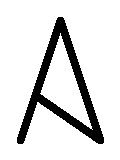|
Phrygian Script
The Phrygian alphabet is the script used in the earliest Phrygian texts. It dates back to the 8th century BCE and was used until the fourth century BCE ("Old-Phrygian" inscriptions), after which it was replaced by the common Greek alphabet ("New-Phrygian" inscriptions, 1st to 3rd century CE). The Phrygian alphabet was derived from the Phoenician alphabet and is almost identical to the early West Greek alphabets. The alphabet consists of 19 letters – 5 vowels (a, e, i, o, u) and 14 consonants (b, g, d, v, z, y, k, l, m, n, p, r, s, t). A variant of the Phrygian alphabet was used in the inscriptions of the Mysian dialect. Words are often separated by spaces or by three or four vertically spaced points. It is usually written from left to right ("dextroverse"), but about one-sixth of the inscriptions was written from right to left ("sinistroverse"). In multi-line inscriptions there is usually a spelling of boustrophedon (a few dozen inscriptions). Alphabet The nineteen charact ... [...More Info...] [...Related Items...] OR: [Wikipedia] [Google] [Baidu] |
Phrygian Language
The Phrygian language () was the Indo-European language of the Phrygians, spoken in Anatolia (modern Turkey), during classical antiquity (c. 8th century BC to 5th century AD). Phrygian ethno-linguistic homogeneity is debatable. Ancient Greek authors used "Phrygian" as an umbrella term to describe a vast ethno-cultural complex located mainly in the central areas of Anatolia rather than a name of a single "tribe" or "people". Plato observed that some Phrygian words resembled Greek ones. Because of the fragmentary evidence of Phrygian, its exact position within the Indo-European language family is uncertain. Phrygian shares important features with Greek and Armenian. Evidence of a Thraco-Armenian separation from Phrygian and other Paleo-Balkan languages at an early stage, Phrygian's classification as a centum language, and the high frequency of phonetic, morphological, and lexical isoglosses shared with Greek, have led to a current consensus which regards Greek as the closest r ... [...More Info...] [...Related Items...] OR: [Wikipedia] [Google] [Baidu] |

